- | 8:00 am
This Airstream has Porsche DNA
A concept collaboration from the famed trailer maker and the firm behind the Porsche 911 combines two iconic vehicles.
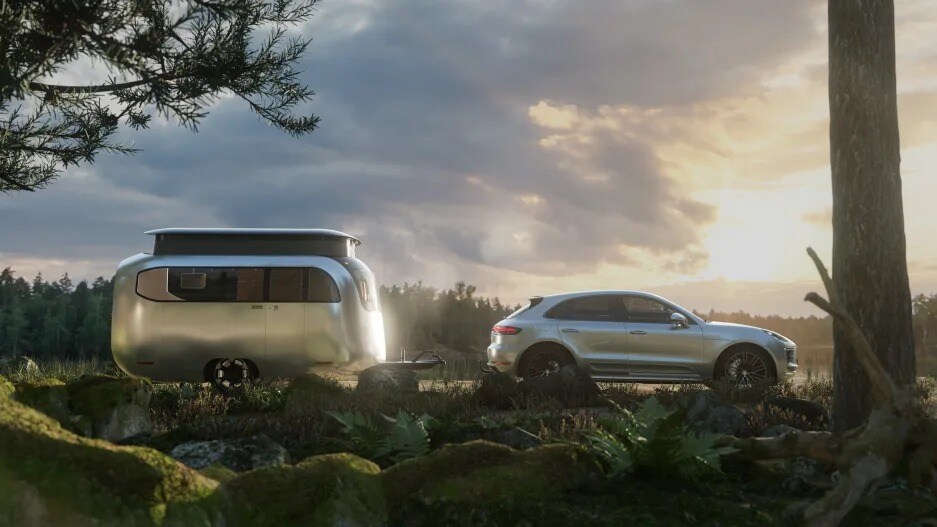
The familiar silver torpedo design of the Airstream trailer is as recognizable as it is revered. The company has been churning out travel trailers for nearly a century, and over that time its overall form factor and design has undergone practically zero change.
So it makes sense that the company’s latest collaboration is with another iconic and aesthetically consistent brand. Studio F.A. Porsche, the industrial design firm founded by the designer of the instantly recognizable and generationally stable Porsche 911 sports car, has tried its hand at reinventing the Airstream.
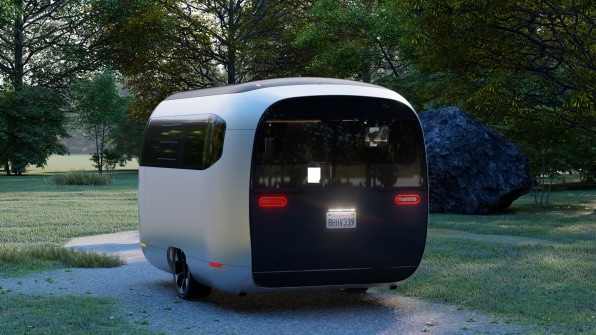
The Airstream Studio F.A. Porsche Concept Travel Trailer is almost exactly what you might expect from two brands steeped in unwavering design. The concept trailer, which will be on display as a one-third model at South by Southwest in Austin beginning March 10, is still recognizably Airstream-y. Clad in familiar brushed aluminum and lined with darkened windows, it’s got the smooth, pill-like form and airplane aerodynamics of the brand’s other vehicles. But it’s also noticeably Porsche-esque, with visually seamless transitions from body to window, and supple panels that look ready for hyperspeed.

Inside, designers from Studio F.A. Porsche optimized the placement of furniture and fixtures, and made traditionally single-purpose devices do double or triple duty. The rear hatch folds open to create an almost floor-to-ceiling opening, and a pop-up roof makes it more comfortable to stand in. Beneath the surface, the design also features a suspension system in the chassis that allows the trailer to lower its profile, squeezing down to fit inside a typical 7-foot-high garage door. Carbon fiber and formed aluminum help bring the overall weight down for better towing by electric vehicles.
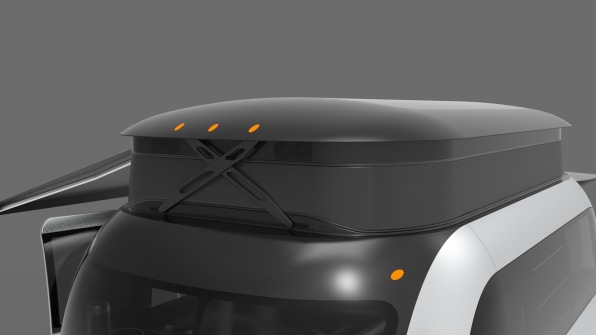
The design blends the luxury-forward detailing of a Porsche with the streamlined but ultimately utilitarian faculties of an Airstream. Bob Wheeler, president and CEO of Airstream, calls the collaboration “a great chance for us to stir things up a little bit and challenge our thinking about what the Airstream travel trailer could be and would be in the future.”
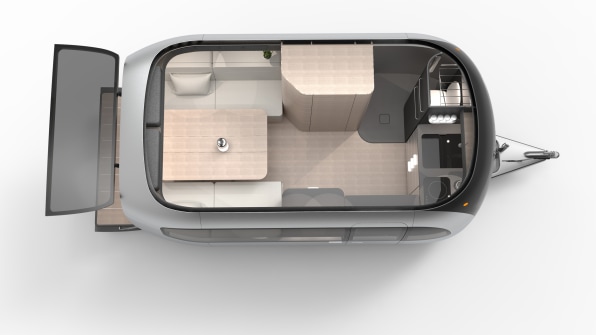
Studio F.A. Porsche was formed in the 1970s when the Porsche family stepped out of the business. The studio was founded by Ferdinand Alexander Porsche—grandson of Porsche’s founder, and the designer of the iconic Porsche 911 sport scar—as a stand-alone industrial design firm. It’s worked on projects ranging from ski resort chairlifts to washing machines to yachts, but vehicle design is deeply ingrained.
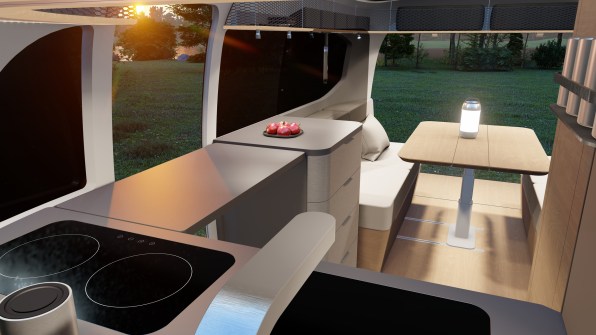
Roland Heiler is the firm’s managing director and the former owner of a 1964 Airstream. He met Wheeler at a vintage trailer show in California more than 20 years ago. The two had been looking for an excuse to work together ever since.
Heiler approached Wheeler with this collaboration concept in 2019. “The timing was really perfect, because we were in one of these moments where we were hunkered down focusing on our core business,” Wheeler says. “What we’re very committed to doing is to invite outside design voices in from time to time, lest we start to stagnate as a brand.”
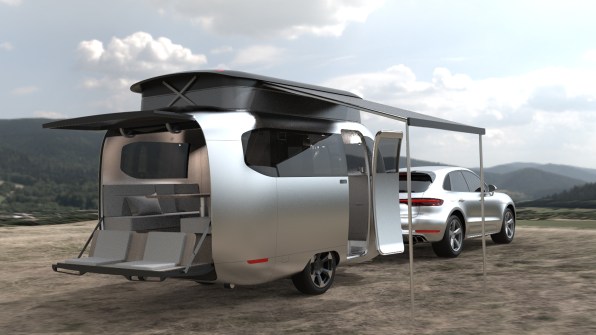
That thinking has led to collaborations like travel trailers stocked with furniture and decorations from Pottery Barn and cozy textiles from Pendleton. Mostly, though, these collaborations have been dressing. The collaboration with Studio F.A. Porsche is much more structural.

Design moves like the fully opening rear hatch and the desire to lower the towing weight for EVs led to big changes in the trailer’s signature shape. “We knew beforehand if we wanted to do an aerodynamically efficient rear end of this trailer we would have to deviate from some of the form factor that Airstream is typically known for,” Heiler says. The result is a more sharply sliced back end, but with rounded corners and edges. “I’m really happy that we found a solution aesthetically that works aerodynamically and it works as an Airstream trailer,” Heiler says.
Notable for the Airstream fans out there—and possibly controversial for the Airstream purists—the concept has none of the rivets that are used to hold the company’s iconic travel trailer together, using formed aluminum fastened behind the surface.
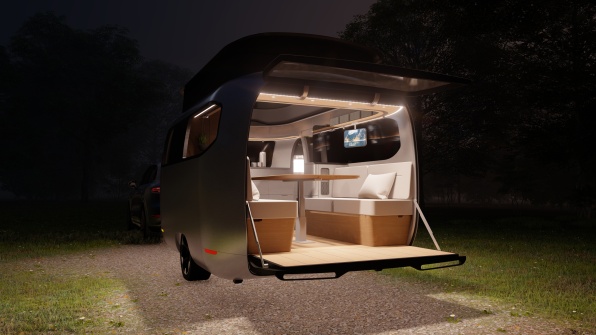
“We love our rivets,” Wheeler says, noting that they’ve been part of the brand’s aviation-inspired designs since the late 1930s. “We claim rounded, aluminum, and rivets in the trailer space. If you claimed all three of those things [in the new design], pedantically what you end up with is what you already have.”
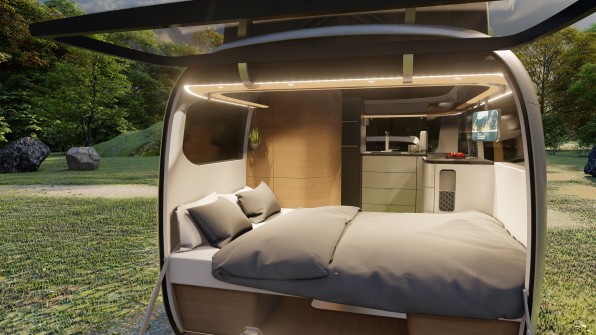
Experimentation has had its upsides for the company. Wheeler says the last major change to the Airstream’s structure came in 2004 with the introduction of the Basecamp, the compact trailer that looks more like a tuna can than a torpedo. “That, maybe not coincidentally, has gone on to become our best-selling travel trailer,” Wheeler says. “It just showed us there’s room to take the Airstream brand and design DNA and form factors in new directions, as long as you don’t abandon what’s really sacred and true about it.”
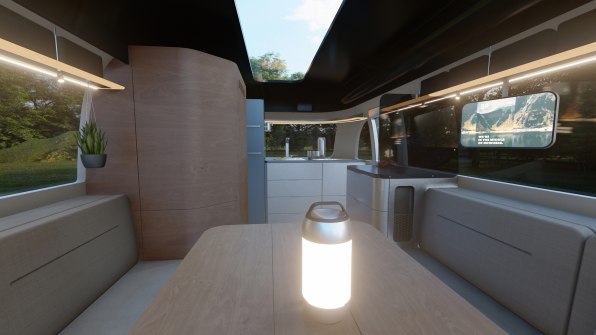
Inside, the design team achieved some notable space savings by packing the shower and toilet in the same area, with a swiveling door that lets the shower double as extra galley floor space when not in use. A fold-down counter in front of the main door adds extra surface area while turning the doorway into a kind of kitchen window.
The concept, by its nature, is just an idea at this point, but Wheeler says that might be temporary.
“I don’t want to overpromise and underdeliver, but we’re challenging ourselves to figure out how we can actually make this thing effectively,” Wheeler says. But he also hedges. “Failing that, there are a number of features here that were cleverly thought out and designed, and that can and will make themselves into future Airstream products.”








































